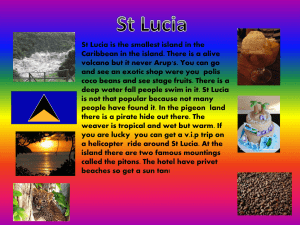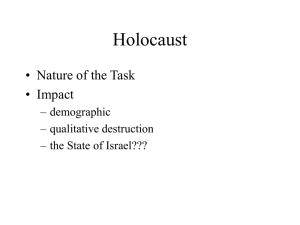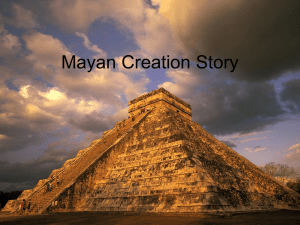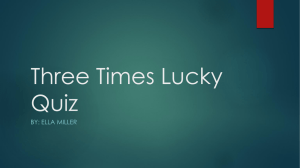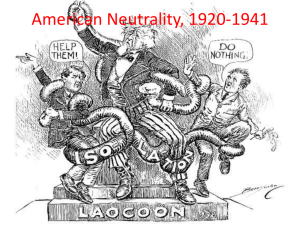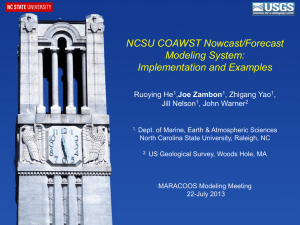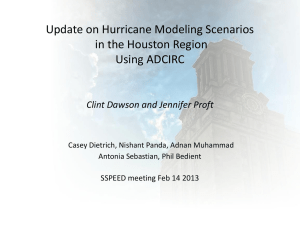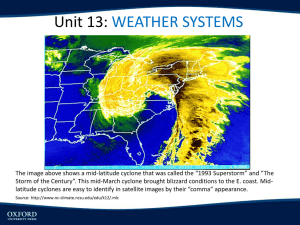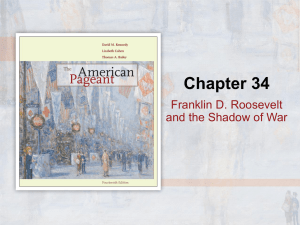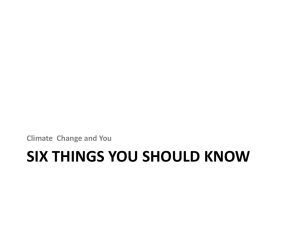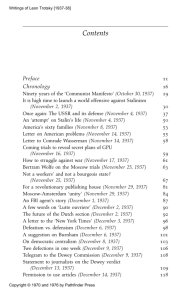The predictability of 1938 New England Hurricane as viewed
advertisement
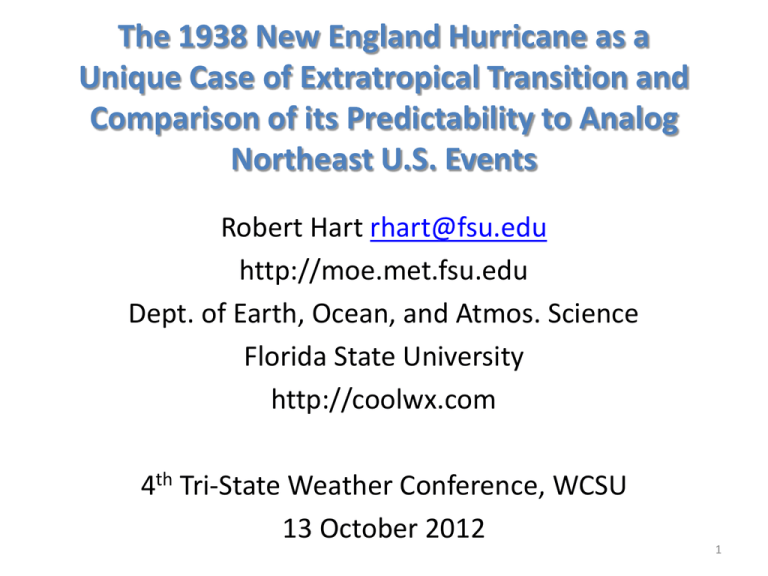
The 1938 New England Hurricane as a Unique Case of Extratropical Transition and Comparison of its Predictability to Analog Northeast U.S. Events Robert Hart rhart@fsu.edu http://moe.met.fsu.edu Dept. of Earth, Ocean, and Atmos. Science Florida State University http://coolwx.com 4th Tri-State Weather Conference, WCSU 13 October 2012 1 Before I begin… 2 1938 New England Hurricane Image references available upon request. 3 1938 New England “Hurricane” • Tannehill (1938) and Pierce (1939) and followup studies identified the interaction of the TC with an unusually strong, perhaps negatively tilted trough for the time of year (last day of summer) • This interaction provided for: – Rapid movement poleward minimizing time over cold water – Another energy source – A NNW track into New England that placed an unusual percentage of the area on the right side of the storm (C. Pierce, Mon. Wea. Rev. 1939) Surface analysis 21 September 1938 NY MA PA VA ? 940hPa MSLP4 1938: Approx. 700mb Analysis Source: Pierce 1939 Monthly Weather Review. Questions • How often does a steering pattern set up for such a landfall? How often is a TC there at the same time? • What was it actually at landfall? • Where in the range of extratropical transition (ET) lifecycles was this case? • What would forecasts be like today if the 1938 TC were to happen again? • Given the availability of new ensemble reanalysis datasets for the period, can we quantify the predictability? 6 Rarity of large scale pattern • Let’s first ask ourselves how often has the pattern across the region been similar to that of the 1938 Hurricane. • First, perform trajectory analysis of parcels starting at the TC location for every 5 day period back to 1957 • Next, isolate those that cross the Long Island/ Connecticut region of New England • Finally, further subset those regimes by time of year to determine the TC feasibility 7 Sampling of five-day forward trajectories at 500 hPa (1957-2002 ERA40) 8 Analog trajectory distribution • Over 45 Years: 196 days during which trajectories passed through the landfall region after starting at 21°N/62°W (4 days a year) • Events: – 155 individual “events” • • • • 114 one-day 32 two-day 7 three-day 2 four-day+ • Monthly distribution (to the right) 9 Analog-TC Synchronicity • Of the 155 periods supporting landfall traj., 109 fell during JJASO. • This results in an estimated two short periods (1-2 day) per TC season on average • But how often is a TC near 21°N/62°W during the TC season? – 33 storms (1957-2002) within 1° radius of 21°N/62°W – 57 storm days over 45 years = 0.84% of the Jan-Oct. period • Illustrates the rare synchronicity required for a NE type landfall • However, this may underestimate the return period given that there can be other trajectory starting points that lead to New England 10 Deficiencies of this estimate • The prior analysis is unsatisfying in two ways: – First, if a TC HAD formed and moved into the analog region, the large scale pattern would have changed from what we observed and thus the storm likely would not have reached New England in the first place. – Second, the prior analysis gives no information on the underlying dynamical features driving the storm structure evolution into NE. • Thus, we move onto ensemble numerical modeling to address this latter deficiency 11 36, 12, 4km Model Domains 12 Model Setup • WRF Model Configuration: – 36, 12, 4km resolution grids (shown previously) – Two-way nesting ; Physics choices available upon request – IC and BCs are 20th Century Reanalysis (Compo et al. 2011) • What is a reanalysis? – A long-term simulation started in the past that constantly assimilates observations – Observations keep the simulations in check – The simulation approach permits analysis estimates where observations are temporarily missing – 20th Century Reanalysis is unique in that it goes back to 1871 • Note: These are simulations, not forecasts. 13 Simulations started every 6hr Color is date of initialization Color is intensity (MSLP) 14 56 Member Ensemble Starting from same Initial Time/Date 15 Initial Condition Sensitivity: Track and Intensity 16 Three clusters of track Left curving Right curving Slow moving 17 Is 1938 a typical case of ET in terms of structural variability/predictability? • The distribution of 56 track and intensity combinations suggests that it is not – but can we refine that? • View the case in the perspective of an Atlantic climatology of ET • Use cyclone phase space (Hart 2003; Hart et al. 2007) as a means to quantify and normalize ET lifecycle. What is it? 18 5 Warm-to-cold core transition: Extratropical Transition of Hurricane Floyd (1999): B Vs. -VTL 4 3 Asymmetric cold-core B 5 4 Asymmetric warm-core (hybrid) 2 3 Symmetric cold-core -VTL 1 2 Symmetric warmcore (tropical) 1 19 Composite Mean ET Structural Evolution Summary 34-Cyclone Composite Mean Phase NOGAPS-analysis based with key milestones labeled TE+24h Trajectory TE TMID TE+48h TB TE+72h TB-24h TB-72h Hart et al. 2007 TB-48h 20 Floyd (1999): Non-intensifying cold-core development Hugo (1989): Explosive cold-core development Charley (1986): Schizophrenia Hart et al. 2007 21 Cindy (1999): Absorption. Dennis (1999): “ET-Interruptus”. Keith (1988): Explosive warmseclusion development Hart et al. 2007 22 Nonfrontal Frontal Structural uncertainty of 1938 New England Hurricane from WRF Ensemble Cold Core Warm-core Cyclone phase space described in Hart (2003; MWR) Nonfrontal Frontal Structural uncertainty of 1938 New England Hurricane from WRF Ensemble Midlatitude/ Winter Cyclone Structure Occluded/ decaying winter cyclone Cold Core Hybrid Structure Tropical Structure Warm-core Hurricane Gloria (1985) New England (1938) Hurricane Floyd (1999) •All three storms had generally similar paths •All three storms occurred within two weeks of each other •The structural uncertainty of Gloria, Floyd are more typical of extratropically transitioning TCs in the region based on prior studies •Yet, the structural uncertainty of the 1938 storm was very different from the other two and had an unusual dominance of dangerous 25 (and rare) warm-seclusion evolutions. Is 1938 Worst-Case Predictability? • 1938 is a nightmare forecast from a structure and impact perspective. • However, is the track uncertainty shown equally nightmarish? • Could it be worse? • Answer is yes: Fujiwhara interaction. 26 WPAC Example: 1974 WPAC Example: 2009 Occurrences in Atlantic (1995) 29 Occurrences in Atlantic (1955) • Example: Diane (left) and Connie (right) • Note the jog west of Connie that may have made landfall further NW than otherwise • Often the interaction is easier to see when analyzed centroid-relative Source: NHC Best-track Schematic of TC-TC Interaction Source: Lander and Holland (1993): QJRMS 1893 New York City Hurricane • Landfall from SSE to SE rather than more typical S or SSW approach • Peaked at marginal category 3 offshore SC • 30 foot storm surge into NYC, LI Source: NHC Best-track Reanalysis: 1893 NYC Hurricane •Nightmare scenario – with three hurricanes interacting with one another. •Fujiwhara interaction is a nightmare to forecast when there are just two storms… Reanalysis: 1893 NYC Hurricane WRF Simulations: 1893 NYC Hurricane • Analogs: Take-home points – A pattern supporting flow into Connecticut from where the 1938 storm was most intense occurs at most a few days a year – Of course, getting a hurricane to be in that area at the same time is more rare. So, we resort to modeling to better understand the predictability of such rare events. • Modeling: – Landfall timing errors of about 6-12hr (too late in the model) – Nearly every type of ET, with strong emphasis on destructive warm-seclusion lifecycle – Dominance of left-curving tracks, remarkable given the rarity in the historical record • Role of Fujiwhara: – 1938’s track was made possible by the interaction with an unusually strong for September (baroclinic) winter type storm to the west. – There are events where such interaction occurs with other hurricanes, with the 1893 New York City hurricane an extreme example of three interacting tropical systems leading to almost chaotic forecasts if performed today 36 Questions • Question: What is sensitivity to ocean temperatures, ocean coupling, model atmospheric physics? Oceans have warmed since 1938. Impact? • Question: How does the TC survive the rapid change in environ. & balance? • Question: How would today’s data change the predictability? – Good aspects of today’s forecast setting: Better ICs and SST, coupling – Bad: The lateral BCs would be forecast not (re)analyses as here. – Is what is shown here the best-case scenario for a repeat, or will a realtime setting forecast be even less predictable than what is shown here? • Question: Given the surprises a well-forecast Irene produced in New England, what surprises might a near-repeat of 1938 produce that we are not ready for? 37
